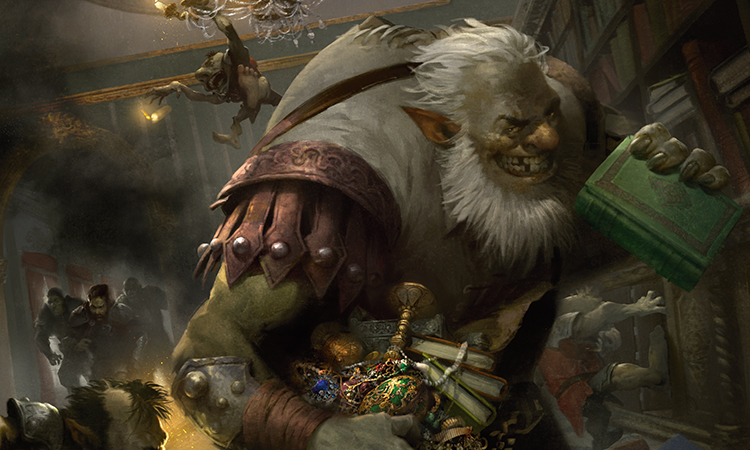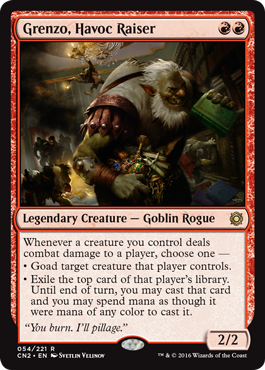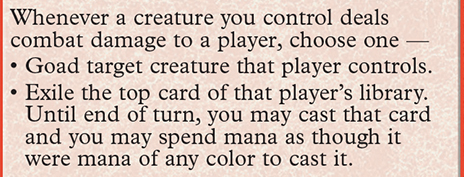Waiting for Grenzo
He's baaaaaack!

I always love when we have the opportunity to revisit characters. And with another round of Conspiracy comes another chance to head to the intricate world of Fiora—and many of the denizens within.
And so let's talk about one of those characters: Grenzo.
When we last saw today's hero, he was positioned in the dungeons of Fiora. He showed us that he's a cut above the average Goblin, and even had a great story you can check out here.
But how has he fared?
Well, Grenzo is, fortunately, alive and well. But his job title has...changed somewhat. He's lost a color in the process. And he's here to raise some massive havoc.
At this point, I think I'd better show you the card. Prepare to meet the new form of Grenzo.

It's time to cause some mayhem.
As a quick recap just in case you haven't been following along with Conspiracy: Take the Crown previews so far, goad is a new ability in this set. When you goad a creature, it must attack next turn and, as long as there is another player other than you to attack, the creature can't attack you. Havoc indeed!
So that's the first option. The second option is card advantage in a pretty major way: for each creature you hit your opponent with, you have a chance to cast a card you wouldn't have otherwise had. (It is very important and worth noting that you cannot play lands exiled this way. Grenzo says cast, not play, which means you can only cast spells with it and not play lands.)
All of this attached to a 2/2 body for just two mana makes for a rather attractive bargain! It's a fine creature you can play on curve, all while providing you a sizable advantage.
While there are many great aspects to Grenzo, there's one in particular that I want to zoom in on today. This is something that you should always be watching out for when evaluating creatures. And while it's far from the only thing to use when trying to figure out how strong a creature is, it is often a good hint that this creature is worth your attention.
Let's hop right into it!
Immediate Impact
There's one thing shared by many creatures: the turn you cast them, they don't do anything for you. Imagine you cast a creature with no special abilities. Blocking potential aside, you spent mana and a card to generate no effect for that turn. If your opponent removes your creature somehow, then it never got to do anything.
Let's imagine a very weird sort of game. Your opponent draws and casts a Runeclaw Bear every turn. Then, you draw and cast a Doom Blade every turn. This game goes nowhere, and eventually someone will deck out.
And while this situation is pretty unrealistic, the idea behind it is this: if you keep trading one card for one card, you get nowhere. However, if you can find a way to break that parity you can start to get ahead—which is one of the core foundations of card advantage. That's why you always want to get as much out of your creatures as possible.
Now, we all need creatures. (Okay, except for you storm combo players.) They're good long-term investments. They can attack until they perish. If your opponent spends a removal spell on them, that's one less removal spell they have for your other creatures. The ability to block right away certainly isn't inconsequential. (Though in Constructed formats there's no guarantee that some opponents are going to be attacking you much at all!) But that doesn't mean you shouldn't also be looking for creatures that have an impact on the game when you cast them—and many of the strongest creatures in all of Magic also happen to be creatures that fit that category.
Let's look at Grenzo's ability again.

An important distinction, and a huge chunk of Grenzo's power, is that the ability doesn't require specifically Grenzo dealing combat damage. Any creature can do Grenzo's dirty work. And that means you can cast Grenzo before attacking, attack, and then reap the rewards of Grenzo if any of your creatures get through. (And the more creatures the better!)
After all, why wait?
Grenzo's unique effect is just one of many ways that a creature can affect the board right away. There aren't many effects exactly like Grenzo's. However, it's in a very similar vein to other abilities that do appear more often—and are worth keeping an eye on when evaluating cards. Let's run through three of the most common ways this might happen.
Haste
Haste! Attack! Damage! Pow! Wham! Bam!
Haste removes that whole part of "your creature not doing anything this turn" by enabling it to attack right away.
With haste, your opponent doesn't know this attack is coming, and it can amount to a burst of damage out of nowhere. Maybe they tap all of their creatures to attack you and hold nothing back, leaving themselves wide open for a haste attack!
Additionally, haste helps creatures be stronger at all points in the game because they're active right away: a Giant Solifuge on turn eight can still catch your opponent by surprise if they didn't leave any blockers around for it, whereas a version without haste gives them a turn to prepare.
It's worth noting that haste is usually most effective in aggressive decks, since doing extra damage in a control deck isn't usually its primary goal.
Enters-the-Battlefield Abilities
Creatures that have an enters-the-battlefield ability (or cast trigger, if you're an Eldrazi) do something right away by replicating a spell-like effect attached to a creature. That way, you're guaranteed to get something out of it.
Often these come in the form of card advantage, but not always. They're a little bonus for playing with that creature.
These can vary widely in effect, as an enters-the-battlefield effect can do basically anything! A good way to check how strong the card might be is to compare it to existing spells that have similar effects, combined with how much the base creature usually costs. For example, compare Lay of the Land and Borderland Ranger.
Lay of the land costs one green. A base 2/2 costs about two mana. Combined you get both—which is actually a fairly potent package, since you're getting two effects: a creature and a spell. While you wouldn't often play Lay of the Land or a 2/2 vanilla creature, combined you get a bit of juice of two cards in one. Some Constructed decks might want this card.
Let's try another comparison.
This is a pretty easy comparison: Mulldrifter can be everything Divination can be, but you also have the option of paying two mana more and getting a 2/2 flyer. Even at five mana it's a pretty solid deal, since Divination costs three and a 2/2 flyer normally costs three, and this is both combined! You should practically always have Mulldrifter over Divination.
Now, this isn't always true—these actually have to be effects that you want in the first place. But if a card is giving you a big discount, it's almost always worth considering.
It's also worth noting that in a similar space are abilities you can activate right away, such as Duskwatch Recruiter or Judge's Familiar, and static abilities that affect your other cards, like Imperious Perfect. These are creatures that, with enough mana or a pre-established board, can still do something immediately if played later on in the game.
Dies Triggers
This one is a little different than the last two. While the others get you ahead by ensuring your creature does something right away, creatures with dies triggers seldom have an effect the turn you cast them.
However, that doesn't mean that they don't have an immediate impact on the board. Your opponent has to calculate how to get around that dies trigger. Are they okay attacking into your creature and having it die? Are they okay removing it? Do they still want to cast their board sweeper now?
Additionally, dies triggers still give you some percentile advantage in the one-for-one race.
Imagine the Runeclaw Bear versus Doom Blade situation from earlier. If each of those Runeclaw Bears deals 1 damage to their opponent when they die, then, even though that single point of damage isn't really "worth spending an entire card on," you will break parity by dealing that 1 damage over and over again. It's just the tiniest amount of advantage that manages to crack open that stall.
Even if they kill off your creature with a dies trigger, you're getting something out of it.
In the Grenzone
Those are far from the only classes of abilities that do things right away, let alone the only thing that is required to make any given creature strong. But if you look among commonly played (and highly drafted) creatures, you'll find many that have at least one of these three traits—or that somehow have an impact on the game right away.
Grenzo looks to continue on with this history.
He makes a great commander as a hard-to-find source of red card advantage, and also something cheap you can cast early. I look forward to beating down with him—and a motley crew of creatures—in Cube drafts. I could even see a shot at Legacy.
So, where will he end up? Well, there's one place I know you for sure you can find him—and that's Conspiracy: Take the Crown! Be sure to check out the set. It was a true pleasure getting to work on the teams for both Conspiracy sets, and I'm thrilled to have another one coming out for you to all enjoy. If you liked the first Conspiracy, you'll love this one. And if you've never tried Conspiracy before, welcome into the fold.
I'll be back next week with more Beyond the Basics. In the meantime, if you have any thoughts, comments, or questions about Grenzo, creature evaluation, or anything else, please feel free to send your thoughts my way! You can reach me on Twitter, on Tumblr, or by sending me an e-mail at BeyondBasicsMagic@gmail.com.
Talk with you again soon! May you be the one launching a conspiracy rather than the one being conspired against.

